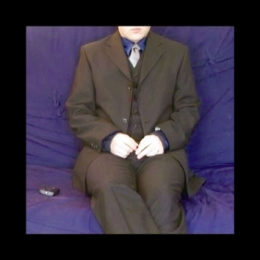art or business
Everyday Series
Everyday Series On view: 18 January – 11 February 2006
Everyday Series, a group exhibition at the kArton Gallery, presents pieces that are based in situations more or less familiar to everyone. The capturing of the chosen moments and the “processing” of the resulting series-thematics, however, are characterised by a poetic ambiance as well as a direct and personal style of performance. The works of János Fodor, Attila Stark, Péter Szabó, Gergely László and Péter Rákosi (photo, graphics, video, object) are linked by the unique – sometimes accidental – selection, and yet conscious combination, of everyday situations.
A selection of photos can be seen from Commuting Artillerymen, a project Gergely László and Péter Rákosi worked together on in 2004, whereby 44 portraits were made of members of three traditional artillery troops from the Tápió region. The photos show the artillery troops commemorating the battle, which took place on 4 April 1849 at Tápióbicske, and which marks the victory of Hungarian troops over the Austrian army. This annual community event entails more than the mere act of dressing in artilleryman uniform on the part of the men of the village. While watching the portraits of the members of these communities mapped out by the artists, we can observe not only the validity of their facial gestures and movements, but also the more nuanced aspects of their identification with the task.
János Fodor questions, through the diversity of various styles and genres, the method by which we relate to everyday reality. In addition to his video work, his graphics done in pencil and pen are also put on display at the kArton Gallery. “These often grouped and intertwined beings, which are also reminiscent of comic book characters because of their similarities and repetitiveness, are powerful mood-concentrates. From time to time they are accompanied by slightly altered quotations with changed meanings, music hits or refrains, thereby giving emphasis to various states of mind.” [1] Fodor’s sculpture exhibited in the Everyday Series is an absurd piece - wrapped in sophisticated irony - from a ceaselessly enchanting collection of objects. In his videos, he captures accidental situations presented in the form of short, lyrical film etudes, as if we were witness to the aimless wonderings through the city of a camera that someone has forgotten to switch off.
Attila Stark’s commentaried, ironic, self-reflective figure may be familiar to us from Little Hungarian Comics, an exhibition in spring 2005. This time, he presents a series, which, similarly to some of his other works, “communicates the feelings and thoughts of the viewer or the doubting artist.” “ The drawings, which are laid out and ordered with poetic sensitivity, often become connected and assume a complementary relationship.” ” [2]
Péter Szabó’s Control shows a reversed situation, which is difficult to describe, it is hard to say who is the viewer and who manipulates the events with a remote control device. The three components of the work are a remote control, a person who keeps appearing in different clothes, and music that can be heard from a TV set that is also always changing. The screen features various characters (from the neck down) pressing the buttons of the remote control in their search for a program that is suits their personality. While the main figure is given different “faces” by the variously styles of clothing (housewife, artist, sportsman, businessman), we find ourselves falling easily into the trap of our own stereotypical ideas about each character.
[1] HELLP, exhibition of János Fodor, Fészek Galéria 15 – 30 December 2004 [2] Zsolt Petrányi : Private Matters? Intimate, Personal, Direct Works, publication, 2005

